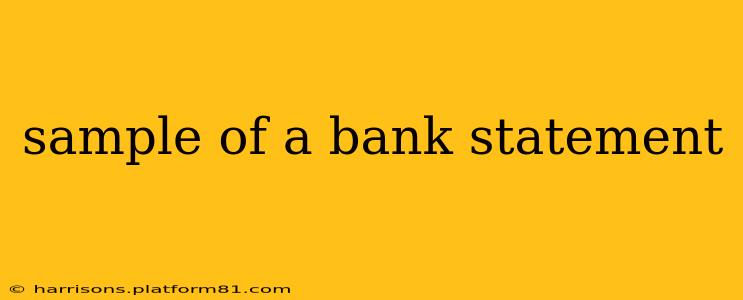A bank statement is a crucial document summarizing your financial transactions within a specific period, typically a month. Understanding how to read and interpret your statement is essential for managing your finances effectively. This guide provides a sample bank statement breakdown, highlighting key components and answering frequently asked questions.
What is Included in a Typical Bank Statement?
A standard bank statement usually includes the following information:
- Account Information: Your account number, name, and the type of account (checking, savings, etc.).
- Statement Period: The dates covered by the statement (e.g., October 1, 2023 – October 31, 2023).
- Beginning Balance: The amount of money in your account at the start of the statement period.
- Transaction Details: A chronological list of all transactions, including:
- Date: When the transaction occurred.
- Description: A brief explanation of the transaction (e.g., "ATM Withdrawal," "Check #1234," "Online Transfer," "Deposit").
- Debit/Credit: Whether money was withdrawn (debit) or added (credit) to your account.
- Amount: The monetary value of the transaction.
- Ending Balance: The amount of money remaining in your account at the end of the statement period.
- Fees (if any): Charges levied by the bank, such as monthly maintenance fees or overdraft fees.
- Interest Earned (if applicable): Interest credited to your account, typically for savings or interest-bearing checking accounts.
- Contact Information: The bank's contact details.
Sample Bank Statement Format
While the exact format varies slightly between banks, here's a simplified example:
| Date | Description | Debit | Credit | Balance |
|---|---|---|---|---|
| Oct 1, 2023 | Beginning Balance | $1,000.00 | ||
| Oct 5, 2023 | Grocery Store | $50.00 | $950.00 | |
| Oct 10, 2023 | Salary Deposit | $2,000.00 | $2,950.00 | |
| Oct 15, 2023 | Rent Payment | $1,200.00 | $1,750.00 | |
| Oct 20, 2023 | Online Transfer | $200.00 | $1,550.00 | |
| Oct 25, 2023 | ATM Withdrawal | $100.00 | $1,450.00 | |
| Oct 31, 2023 | Ending Balance | $1,450.00 |
Note: This is a simplified example. Real bank statements may include more detailed descriptions, transaction IDs, and additional information.
How Often Do I Receive a Bank Statement?
Most banks issue bank statements monthly, but some offer options for more frequent statements (e.g., weekly). You can usually access your statements online through your bank's website or mobile app as well.
What if I Don't Receive My Bank Statement?
If you don't receive your statement by mail, check your online banking portal first. If it's not there, contact your bank immediately. Missing statements can indicate potential issues with your account.
How Can I Reconcile My Bank Statement?
Reconciling your bank statement with your own records (checkbook, budgeting app, etc.) is crucial to ensure accuracy and detect any discrepancies. This involves comparing every transaction listed on the statement to your records and identifying any potential errors or unauthorized activity. If you find discrepancies, contact your bank promptly.
Can I Get a Copy of My Bank Statement?
Yes, most banks allow you to obtain copies of your bank statements, either by printing them from online banking or requesting a paper copy from your branch. Keep in mind that there might be fees associated with requesting paper statements.
By understanding the contents and purpose of a bank statement, you can effectively monitor your finances, spot potential problems, and maintain a healthy financial relationship with your bank. Remember to regularly review your statements to ensure accuracy and detect any unauthorized activity promptly.
